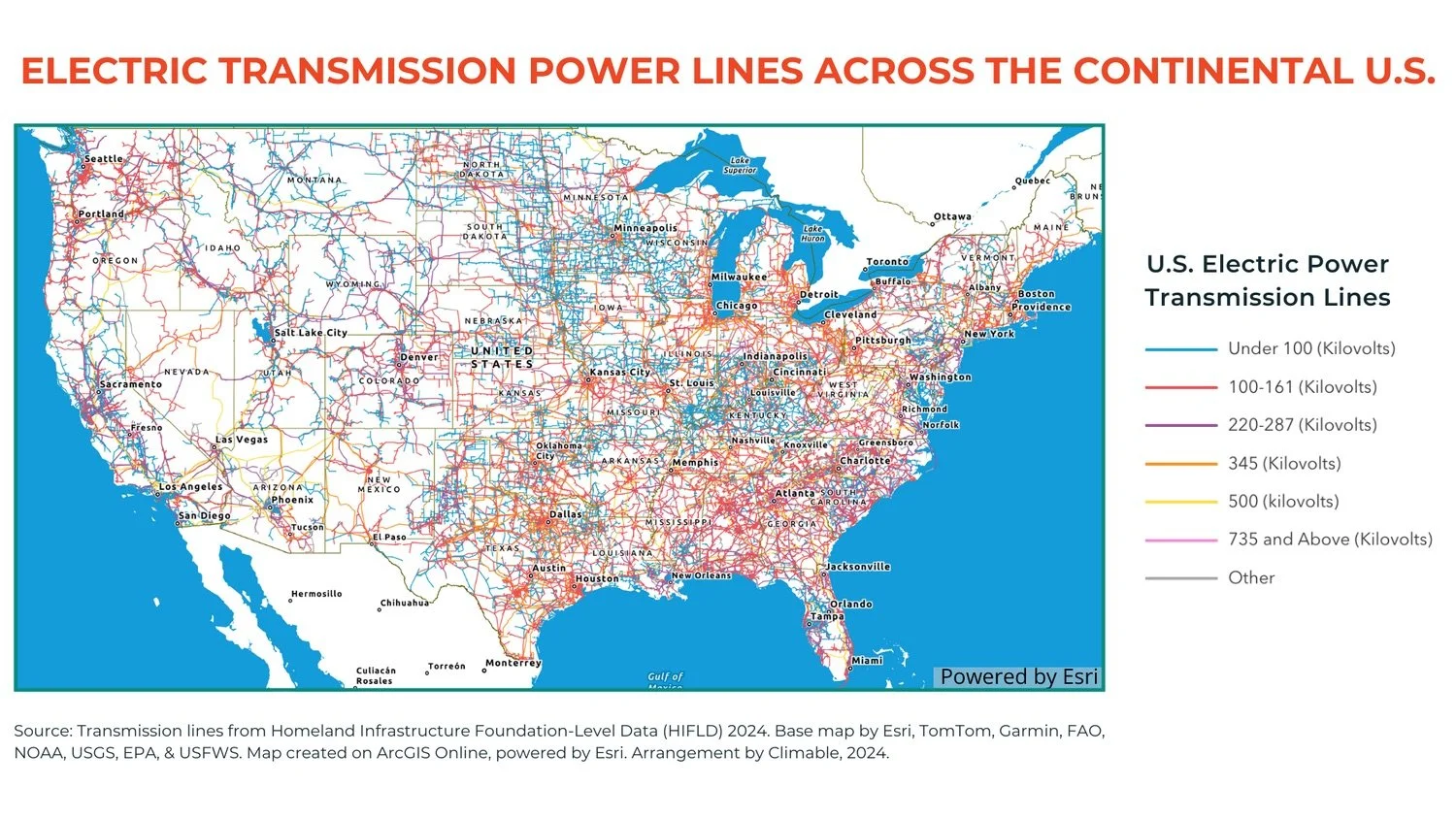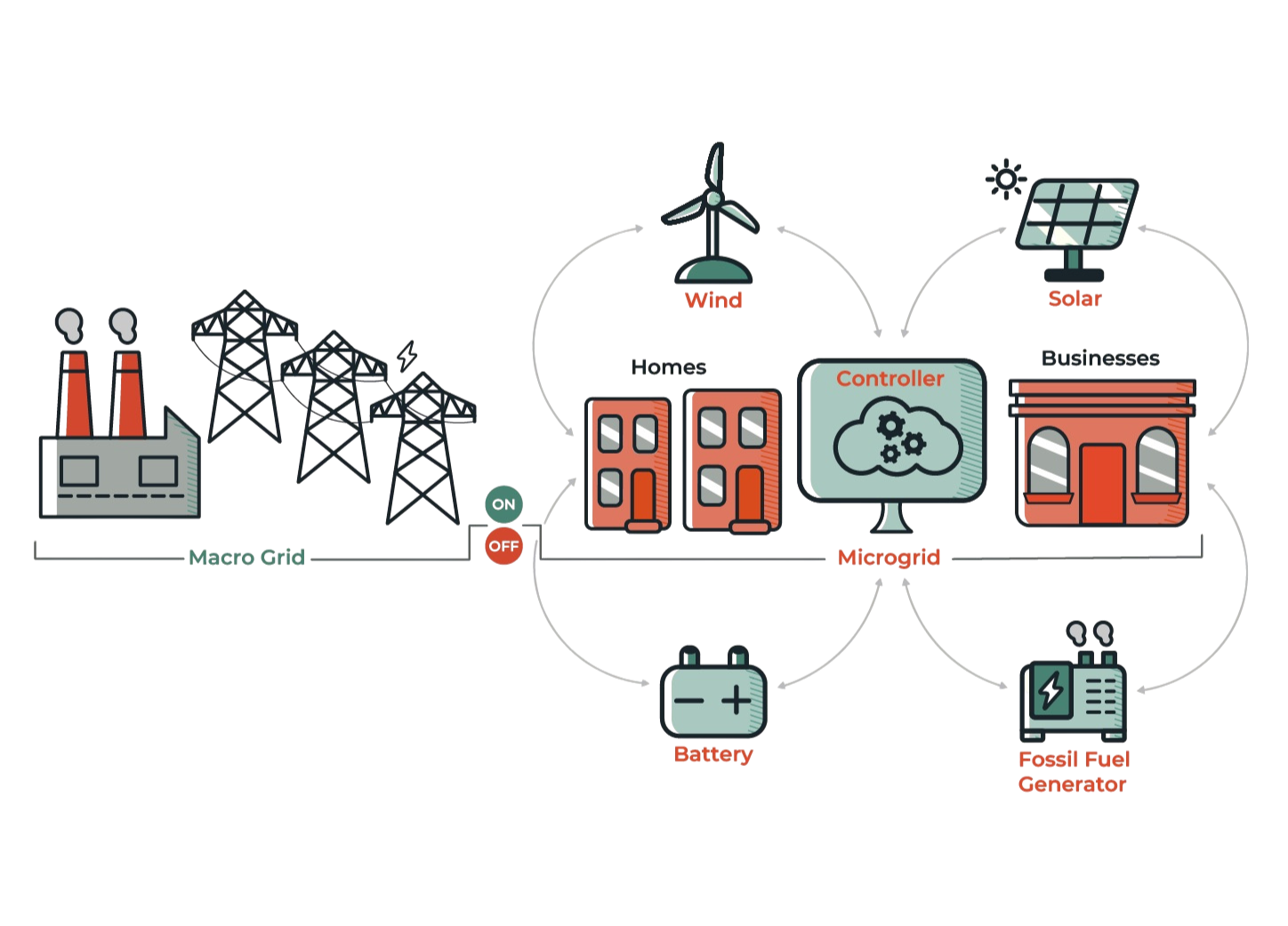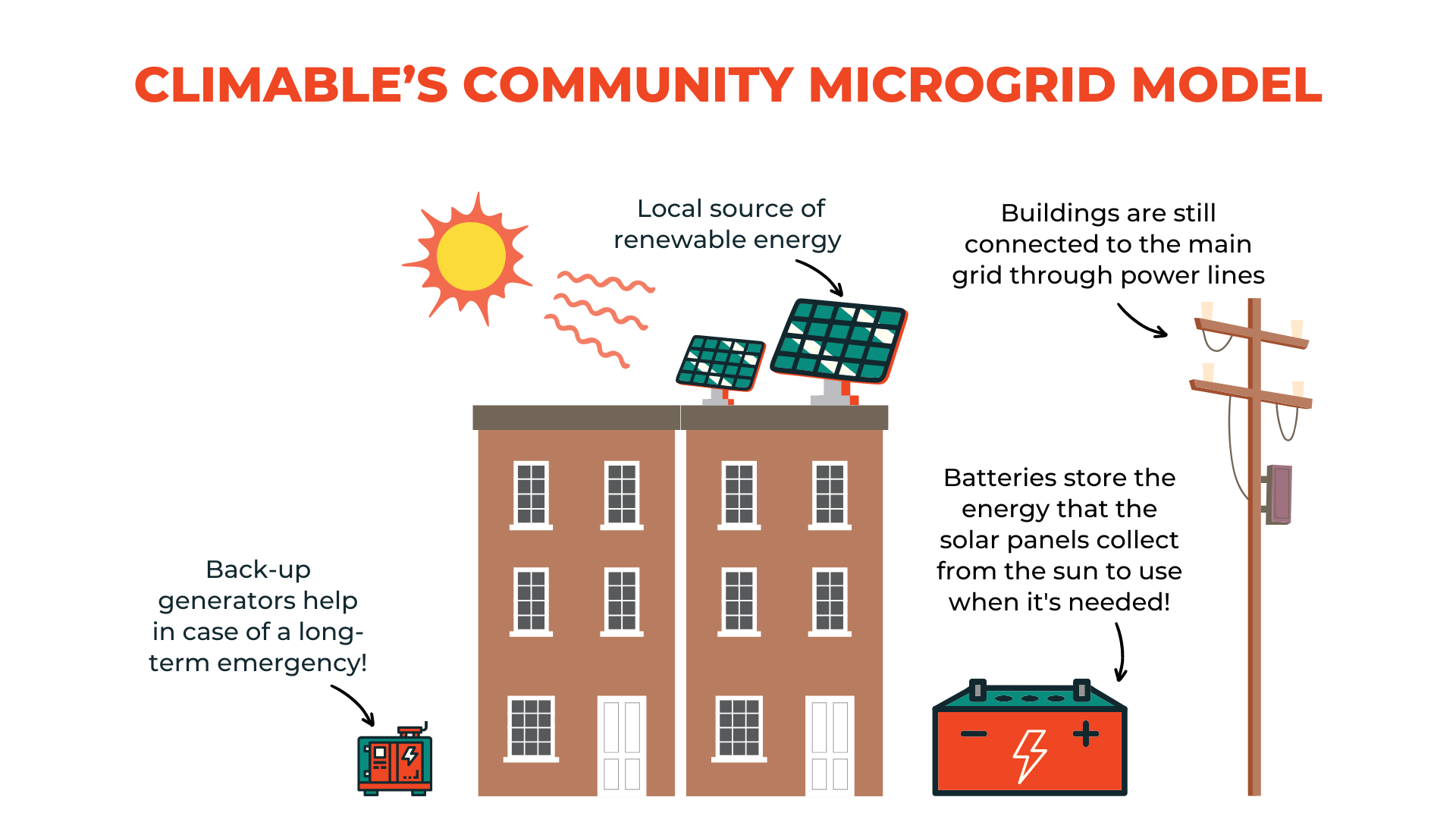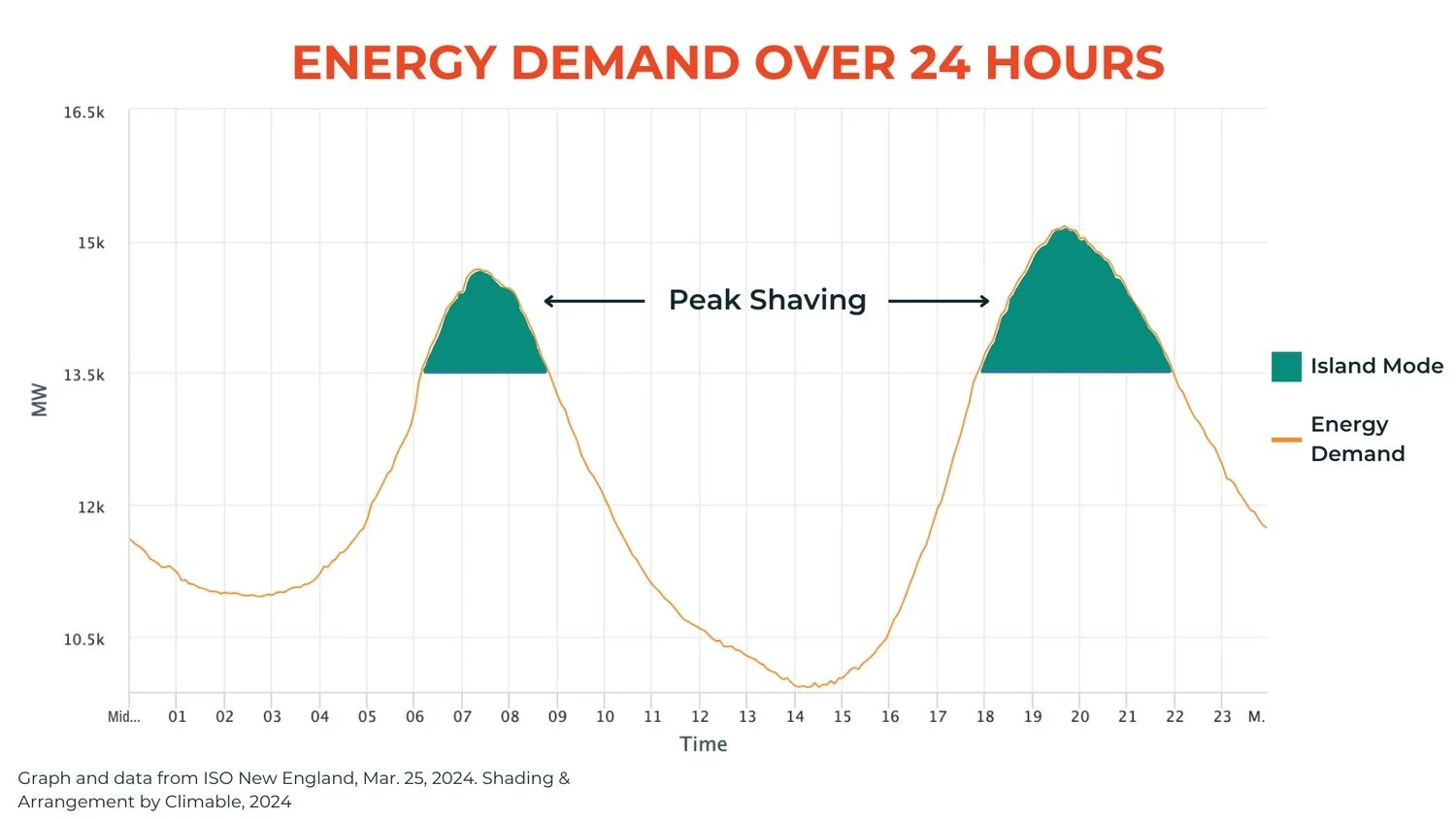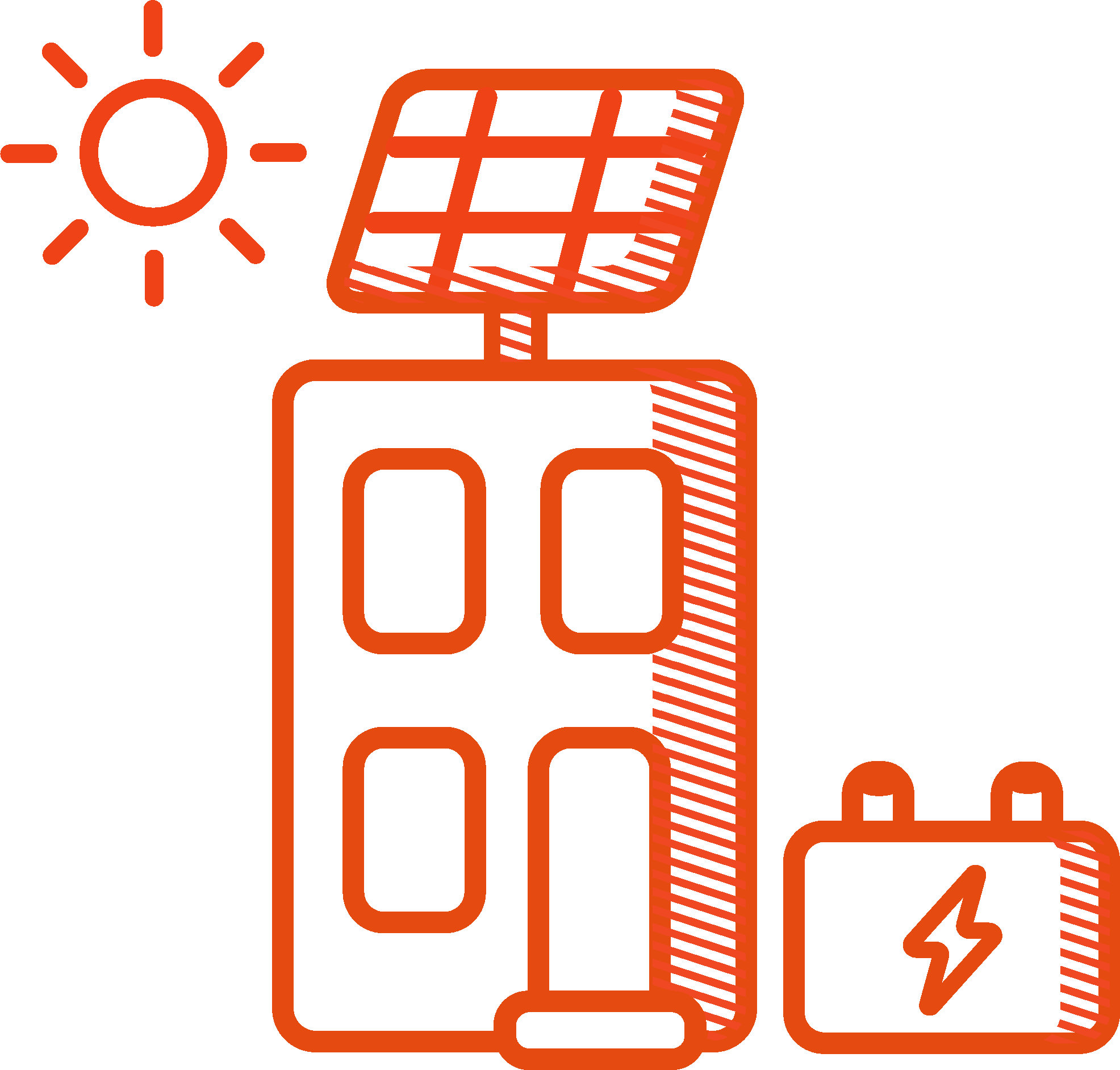Microgrids
What is a Microgrid?
A microgrid is a small-scale energy system that produces and stores electricity for local buildings. It can operate independently or in coordination with the larger power grid system. For example, some military bases and university campuses generate, store, and use their energy instead of relying on the central grid. Others may use their microgrid as a backup electricity source if there’s a power outage on the larger power grid.
Microgrids can be a powerful solution for communities. Climable’s model uses them to provide backup power and financial savings for environmental justice communities. We aim to strengthen community resilience through increased energy reliability in critical facilities, participation in energy decision-making, and access to economic savings from clean energy use.
This map shows the network of transmission lines in the continental United States, which are the thick power lines on the tall metal towers. Smaller distribution lines that connect directly to homes and buildings are not shown. They would fill in much of the white space between the transmission lines. Click the image to explore the interactive map on ArcGIS Online. Graphic: Climable, 2024
“Macro” vs. “Micro” Grid
The larger power grid system powers most homes, businesses, and industrial sites. It is also known as the macro grid or, more commonly, simply “the grid.” It is a network of power plants and power lines across the entire country. The power plants generate electricity in a centralized location, often far away from the end users. The electricity produced is then carried across hundreds of miles of transmission and distribution wires, connecting the power plants to homes and businesses.
A microgrid also powers homes, businesses, and industrial sites, but on a much smaller scale. Because they are smaller, microgrids only power a certain community, neighborhood, or set of buildings. They generate electricity locally, often on or near the site of the buildings they power, rather than far away.
A simplified visualization of a microgrid. The macro grid is shown on the left, and the different microgrid components and participating buildings are on the right. The point of interconnection between the macro grid and the microgrid is displayed as an on/off switch, representing the microgrid’s ability to switch between grid-connected and island mode. The controller in the center of the microgrid coordinates this switch and the use of the different microgrid components. Graphic: Rachel Liang for Climable, 2024
Components of Microgrids
Local generation: Electricity for a microgrid system can come from multiple sources and be powered by fossil fuels, renewables, or a combination of both. The sources of electricity are located very near the buildings they power.
Battery Storage: Most microgrids include battery storage. Batteries store energy from the local generation source that can be used to power buildings as needed. Batteries can store electricity during hours when electricity demand is low on the macro grid, and power the connected buildings later, when energy demand is high. Any extra electricity generated after the battery storage is full can be sent back onto the grid to supply electricity to other areas.
Island Mode: Microgrids can connect and disconnect from the grid. If there is a grid disruption or power outage, microgrids can disconnect from the grid and power the connected buildings. This is known as “island mode” or “islanding”.
Local Service: Microgrids only serve a specific area or a limited set of buildings that are physically close together.
What is Climable’s Microgrid Model?
There are different reasons and approaches to developing a microgrid. At Climable, we see microgrids as a way to provide resilience and energy security to a community. Climable develops microgrids in environmental justice communities. Environmental justice communities are marginalized communities that face disproportionate environmental burdens and experience more frequent and intense heat waves, floods, and other adverse climate change impacts. Often, environmental justice communities experience more frequent grid disruptions and outages than wealthier, whiter communities. We develop microgrids that include community centers, emergency shelters, and other critical facilities that can provide necessary services for the community during an emergency. We are dedicated to empowering communities in the energy transition and making clean energy accessible to everyone.
A visual example of Climable’s microgrid model applied to buildings in a neighborhood. During a grid outage, the buildings could draw power from the solar panels, battery, and backup generator; they can also switch into island mode during periods of high electricity demand to save money. Graphic: Rachel Liang | Climable, 2024.
Climable’s Microgrid Model Is:
Community-Led: Communities always come first in our projects. We work alongside community organizations to create energy literacy campaigns and gather the community’s input on their wants and needs regarding the design of their microgrid. Community representatives make key decisions about the design and operation, and we work to ensure that the community owns the solar panels and batteries once installed.
Clean Powered: Solar panels and batteries provide the local electricity source, and we’re increasingly including bio-fueled backup generators in our models. We strive to use clean energy assets wherever and whenever possible.
Smart & Virtual: Our microgrids are virtual. They use a cloud-based software management system, so buildings don’t have to be next to each other or physically connected. This allows any building to be included in the microgrid regardless of its geographical location. The virtual nature also avoids violating Utility Franchise Laws, which prohibit the connection of buildings across a utility’s “right of way”.
A main virtual controller coordinates the components and buildings of the microgrid. This sophisticated software and cloud-based system is smart; it can help achieve the lowest prices, the cleanest energy, and the greatest electric reliability. The main controller also knows when and how to seamlessly switch to island mode in case of an outage or grid disruption.
Energy Efficient: Climable also encourages energy efficiency upgrades to participating buildings, such as installing smart appliances and energy-efficient heating and cooling systems that can reduce energy use. Communities can advocate to have such upgrades to be made in their buildings.
What are the Benefits of Climable’s Model?
Reliability and Resilience
Microgrid infrastructure can help communities during unforeseen emergencies, including climate change-related power outages, flooding, heavy rain, and major storms. Loss of power and communication connection is especially problematic for critical facilities like hospitals. Clean microgrids that use renewable sources like solar power can improve electricity reliability and resilience. Adding energy storage capacity through batteries and backup generators provides additional reliability and resilience during prolonged outages. This prevents disruptions in power from the generation source, making the microgrid system more reliable for communities. Microgrids are also flexible—additional solar panels or batteries can be added as needed. This distributed nature—having multiple sources of generation and storage—further decreases the risk of failure that a single energy resource faces. By creating redundancies, clean energy microgrids result in a more reliable and resilient electric system than centralized fossil fuel power plants alone. This is crucial for maintaining functioning communities during emergencies.
Public Health Protections
Power outages can have significant consequences on public health. For instance, critical infrastructures like hospitals, water treatment facilities, and nursing homes rely on electricity for their safe operation. Outages due to climate-driven events such as hurricanes and heat waves have caused sewage overflows, health facility shutdowns, and loss of life. Microgrids designed for and with communities can protect public health in these situations by keeping the power flowing. However, the benefits of microgrids for public health depend on their design. For example, microgrids at commercial sites may provide financial benefits for the building tenants, but will not necessarily support community resilience or mitigate public health risks from grid outages. Instead, microgrids should be part of a broader planning strategy to strengthen critical services that a community relies on during grid failures and weather emergencies. When developed intentionally, with community input, microgrids are a vital tool for improving community resilience and health equity.
Efficiency and Costs
Microgrids can decrease the amount of electricity that must be transmitted from centralized power plants to end users when island mode is used at strategic times. Transmitting electricity long distances loses a large amount of energy as heat on the power lines. This loss can be decreased by generating and using electricity locally, improving the grid’s efficiency.
Islanding during periods of high energy demand, or “peak hours,” can further improve the grid’s efficiency and lower electricity costs for people in the microgrid—this is known as peak shaving.
Community Ownership
Our microgrid model ensures that community members own the solar panels and batteries in their microgrid, giving them greater control over their energy supply, costs, and resilience. This community ownership approach promotes energy democracy, an alternative, people-centered model of energy management and decision-making. We provide literacy materials so all community members have the necessary information to participate in decision-making.
This graph shows the amount of energy demand in megawatts on the grid in the New England region over 24 hours, depicted by the orange line. The blue shading represents peak shaving created by periods when a microgrid is in island mode. Graph arranged by Climable, 2024.
What are the Challenges to Microgrid Development?
Money and Funding
The upfront costs of microgrid components like solar panels, batteries, and the control system are extremely high and unaffordable for low and moderate-income households. Investors are often hesitant to fund community microgrid projects because the technology is still relatively new and they can’t guarantee their investment will be repaid. Estimating the monetary benefits of resilience and energy reliability is challenging, so there is little motivation to invest funds into such projects.
Regulations and Laws
In order for microgrids to send and receive energy to and from the grid, they must be connected by a single point to the distribution lines of the grid, called “interconnection.” Local utilities must approve interconnection and sign an Interconnection Service Agreement (ISA). ISAs ensure that technical standards are followed to maintain safety and reliability when a microgrid connects to the wider network. However, developing an ISA involves lengthy and costly technical reviews. If you’re curious, you can read Eversource’s ISA here.
Additionally, Utility Franchise laws mandate that only electric utility companies can connect buildings with different owners to one another. Buildings on a college campus or military base, owned by the same owner, can be physically connected by wires in a microgrid. However, under Franchise Laws, two apartment buildings owned by different individuals or companies cannot be combined unless a utility owns the microgrid. This is where the virtual component of Climable’s microgrids comes in handy. The virtual controller connects all the other components via the cloud software system, rather than physical wires.
Building Requirements
Many requirements must be met before microgrid components can be built. To install solar panels on buildings, rooftops must meet certain criteria. They must be mostly flat and not shaded by trees or other buildings so the maximum amount of sunlight can reach the panels. They also need to be strong and sturdy enough to support solar arrays throughout their typical 20-year lifespan. Any major planned renovations must be done before the solar panels are installed because panels can’t be removed and reinstalled at a reasonable cost. The size and space of roofs also influence the capacity of a solar array—the bigger the roof, the bigger the array. If your roof is too small for an adequate number of solar panels for the size of your building, then it won’t be worth installing them.
Batteries also have several requirements that must be planned around. According to fire codes—requirements for fire safety—batteries must be installed on the ground floor (“at grade level”) and a certain distance from surrounding buildings. This makes it difficult to find an appropriate location in dense urban areas. Additionally, before installing any equipment or undergoing any microgrid process, technical experts must perform an in-depth feasibility study that evaluates if the microgrid will meet all the legal and safety requirements.


